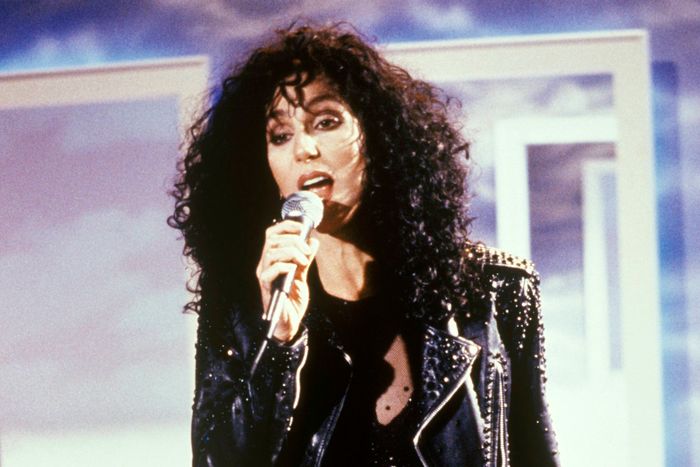
Cher first became eligible for the Rock & Roll Hall of Fame in 1990, 25 years after her solo debut, All I Really Want to Do. It was only the Rock Hall’s fifth year of existence, and the institution was still trying to fill some obvious gaps. Influential acts like the Who, the Kinks, and Simon and Garfunkel were all inducted that year. So how could voters justify embracing a trend-chasing pop star like Cher, especially before Joni Mitchell or Ike and Tina Turner had had their shot? They wouldn’t — despite remaining eligible, Cher didn’t make the nomination ballot until last February, when the Hall finally voted her in. But despite three and a half decades of skepticism, she has always belonged in the Rock Hall, and her induction rectifies one of the most embarrassing snubs in an institution full of them.
It can be easy to forget how entrenched Cher is in rock history. Some of her first recording gigs were singing backup on influential hits like the Ronettes’ “Be My Baby” and the Righteous Brothers’ “(You’ve Lost) That Lovin’ Feeling” after Sonny Bono introduced her to super-producer Phil Spector. Her first solo single was a cover of Bob Dylan’s “All I Really Want to Do,” which outperformed a competing take by the Byrds on the charts, peaking at No. 15. Between her duets with Bono, like their No. 1 hit “I Got You Babe,” and her solo career, she quickly became a leading figure in the burgeoning world of pop rock, charting a separate path from the rockers, the folk songwriters, and the R&B singers of the time while becoming an early icon of hippie fashion.
That didn’t last long. She and Sonny were soon supplanted by the more electric hard rock of the late ’60s, so they pivoted to hosting a popular television variety show to stay in the spotlight. Cher continued recording but didn’t find success again until 1971, when her folk-inflected pop song “Gypsys, Tramps & Thieves” reached No. 1. That set off a string of similar hits, turning her into a bona fide pop star — by the time “Dark Lady” topped the charts in 1974, she’d broken the record for most No. 1s by a female recording artist. These songs unfortunately used Cher’s tenuous ancestry to play up stereotypes, but they also showcased the singularity of her rich, powerful contralto. It still wasn’t “fulfilling,” though, Cher admitted — she wanted to be accepted by the rockers, not be a pop star. “I’m not a Cher fan,” she later said of those early ’70s hits. The feeling would inspire her 1975 album Stars, featuring poignant, exceptionally sung Jackson Browne and Eric Clapton covers. But that collection of rock songs wasn’t what listeners wanted to hear from Cher, and it failed commercially and critically. “Cher is just no rock and roller,” wrote the critic Janet Maslin.
Cher had undeniably become one by 1990, the year she was finally eligible for the Rock Hall. After wandering the musical wilderness for most of the ’80s, she began working with some of the era’s biggest hitmakers, including Jon Bon Jovi, Richie Sambora, and Desmond Child. On her 1987 self-titled album, she brought a pop sensibility to the hair-metal anthems dominating the airwaves with a voice that could command attention over the loudest guitars. She rocked even harder on her 1989 album, Heart of Stone — incredibly, her highest-charting project yet — and its larger-than-life single “If I Could Turn Back Time.” While most artists would have eased into legacy-act status by the time their Rock Hall eligibility rolled around, Cher was recording some of the best songs of her career and actively moving the needle in popular music.
Yet to gatekeepers and purists, she was still an impostor, a pop star trying on a hot-rock sound for yet another career revival. On one level, that’s exactly what she was doing. But that’s no crime — in fact, it’s become a blueprint for artists after her. Cher had eras before Madonna released her first song or Taylor Swift was even born: her early folk-pop, the rock of Stars, disco on 1979’s Take Me Home, new wave on 1982’s I Paralyze. Yes, some of her albums flopped, but she always managed to follow them up with increasingly improbable successes. She proved it again in 1998, when she introduced Autotune to pop with “Believe” and became the oldest woman at the time to top the Hot 100. “Well I know that I’ll get through this / ’Cause I know that I am strong,” Cher wailed in the bridge, as if it had been her mantra during the past three decades.
For years, it felt as if everything that made Cher special also built the case against her rock talent. Her use of Autotune in “Believe” was predictably criticized at the time, but it proved to be visionary. In that review of Stars, Maslin wrote that Cher specializes in “image, not music,” as if a pop star can’t also be a fashion icon. Cher may not have written her own songs, but she could make anything she sang into a Cher song, just like past Rock Hall inductees Linda Ronstadt and Whitney Houston. Love or hate her voice, it was unique — often imitated, never replicated.
Cher made headlines last year after telling Kelly Clarkson the Rock Hall can “go you-know-what themselves” after snubbing her for so long. “I wouldn’t be in it if they gave me a million dollars,” she said, just a few months before her eventual nomination. Can you blame her for feeling that way? She’d seen multiple of the acts she once sang backup for, many artists whom she beat on the charts, and even an ex-husband get inducted into the Hall before her. Madonna, one of Cher’s biggest followers, was a first-ballot inductee in 2008. Her one-time producers in Bon Jovi were inducted in 2018 despite being seen as one of the Hall’s worst picks ever. (As the Hall began acknowledging the ties among rock, pop, and disco in the 2010s, Cher’s absence became more and more inexplicable.) In 2010, she also mused of Sonny & Cher’s absence, “We influenced a generation, and it’s like: What more do you want?” But Cher didn’t owe the Hall anything else — it owed her.


